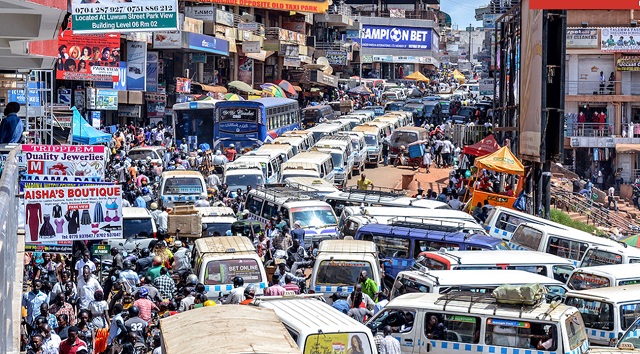
What next as city’s busiest street goes car-less, gets recreation parks?
Kampala, Uganda | RONALD MUSOKE | Luwum Street has been one of the busiest motorized sections of Kampala city for years. Located just a block off the city’s main access; Kampala-Jinja Road, and connecting to the city’s main international gateway; Entebbe Road, Luwum often has bumper to bumper traffic from morning into late night.
Everyone appears to be in a hurry although everybody moves really slowly as the roads are jammed with cars, bodaboda taxi motorbikes, and human mules carrying heavy loads from one section to the other. Up to 90 percent of people in this area walk, yet the roads appear to have been designed for the few using motor vehicles. Moving on foot along this route is a tricky balancing act.
That is perhaps why, when the city planning authorities, mooted a plan to decongest the city, Luwum Street was top on the list. In the end, remaking the street has become a test case of Ugandan urban planning to favour the majority who either walk or cycle.
Kampala Capital City Authority (KCCA) is using Luwum Street to innovate a new city experience involving introduction of what are dubbed ‘pedestrian shopping streets.’
KCCA says the old Luwum Street of bumper-to-bumper motor vehicles will be redesigned into a car-less space with walking paths to encourage walking as a way of living healthy, wider green spaces for recreation, street benches and shades for tired shoppers.
Like many cities in the world, Kampala city’s public transport is highly polluted, congested and time/energy consuming.
In order to promote bicycling, walking and physical activity, cities and towns around the world are closing streets to cars and opening up to a variety of modes and uses. Using these temporary street closures, communities have safe and convenient opportunities for bicycling and walking.
Urban planning experts say half of all trips in Kampala are short and within cycling and walking distance with about two million people using public transport. Public transport continues to reflect challenges to city authorities and urban planners.
There are significant barriers within a city that discourages physical activity such as the presence of high volume, high-speed roads; safety concerns in street and side-walk design; poor air quality and lack of public parks.
Luwum Street faces all these challenges. But it is also no stranger to change. Historically it boasted the first shops in Kampala in the early 20th century and was renamed after a prominent Christian leader who was martyred during the Idi Amin reign of terror in the 1970s. But the coming change looks set to be the most dramatic and perhaps impactful.
Since April 2018, KCCA has been remodeling Luwum Street and its sister road, Namirembe Road. The two are in fact one 2km road, although the Namirembe section was so named possibly to indicate its direction to Namirembe Cathedral when it was constructed.
Together, Luwum and Namirembe literally cut through the centre of the city from north to south. From the north, the route carries all the traffic entering the city from the two main veins of Hoima Road with 40,000 vehicles per day and Gulu Highway with over 35,000 vehicles per day and the south Luwum Street is the main artery for cars going out of the city to the east along Kampa-Jinja Road with over 50,000 vehicles per day. Along the way they traverse some of the busiest motorized and human traffic locations in the city; two taxi parks, two main city markets and several bus parks.
The roads are also mostly lined with shopping malls, and the city’s main business hub; the Kikuubo area, and a few theatres. Throw in the hundreds of pedestrian that throng the area daily as bus or taxi passengers, traders, and shoppers and you have a true medley of moving bodies. KCCA wants to change that.
KCCA’s intervention is in line with the National Non-motorized Transport Policy whose primary objective is to increase the recognition of walking and cycling in transport planning and design. It revolves around provision of safe infrastructure for pedestrians and cyclists.
The Shs 4 billion project is funded by the government and other partners including the United Nations Environment Programme (UNEP) and UN-Habitat. It is being implemented as a pilot study to assess its efficiency in Kampala.
Under the plan, providing resources of walking and cycling in the city’s financial planning and developing and adopting universal design standards that provide for access to all sectors of the community will get more attention. The city will also improve regulation and enforcement to enhance safety for pedestrians and cyclists.
When The Independent recently visited the stretch, which takes about 20 minutes to walk, workers of Stirling Civil Engineering Ltd were busy marking some sections in the Bakuli area on one end of Namirembe Road to the north with green paint. On the northern end of Luwum Street, more workers appeared to be putting final touches on the pedestrian walkways. Work on the Luwum section started in November last year and was expected to last a month. But that was stretched and KCCA now says everything should be ready by March.
 The Independent Uganda: You get the Truth we Pay the Price
The Independent Uganda: You get the Truth we Pay the Price




A failed tv personality turned urban planner spends a few days in Europe and enjoys the experience of riding a bicycle in the middle of European city and returns home and wants to do same in stereotypical African city regardless of culture misfit and the negative social and economic impact and anyway her wishes are quickly and easily granted..and be damned the hapless entrepreneurs and others whose livelihoods will be ruined by this sillyness .
If non motorised transport corridors are good why not start with planting flowers and allowing only pedestrians on the Jinja road-kampala road- bombo road corridor. Even better why not experiment this in places like kololo, bugolobi, nakasero, naguru were the obese residents would generally benefit from the forced walking.
Money wasted on this hairbrained scheme would have been better spent on the million-challenges Kampala faces such as:
– Repairing the potholed roads of the city
-Improving tarmac coverage from the lowly 500km.
-Providing street lights in the mostly dark streets of Kampala more so the business areas like kikuubo,Nasser road to encourage development of a night economy.
-Upgrading of slums thru constructing of affordable public housing for Kampala’s urban poor.
-And the list could on and on and still wouldnt include this non-motorised-transport scheme for self indulgent “elites”
Well, sincerely, the Namirembe Road – Luwum Street corridor has for so long been the “most walked” or one of the “most walked” corridors in Kampala, with such huge volumes of pedestrians.
Driving there has always been a nightmare and the pedestrians in that part of town include those whose means of transport is walking as well as those who can’t risk driving in that section of town.
This NMT corridor, in my opinion, is one of the few projects in Kampala that have been inspired by a need: the need to ensure that walking is made easier and safer in an area where walking is the biggest means of transport.
All the things you mention are important and sure need to be done but not at the expense of a safe non motorised space.
Great piece, Ronald!
“Urban planning to favour the majority who either walk or cycle.” is an excellent idea on every continent. It is certainly not silliness that will ruin livelihoods. Every city where the transition towards friendlier streets has started, soon sees the benefits are much bigger than disadvantages are. People get healthier and happier, streets are less congested, social live improves and road safety improves. These changes support each other and create a spiral towards a successful city. Healthy happy people are more productive and active children perform better at school. Kampala’s urban poor do not profit from motorized transport Walking and cycling are not for the self indulgent elites, they are for everybody.
Cities in Europe are the first to embrace cycling as an important form of transport, but experts agree that the model is the answer to many problems in every urban area. All over the world city policy makers are becoming aware of the fact that the classic ‘motorized’ city is just not sustainable. Lately I see more news from Africa on the subject and that is very good. Walking and cycling have a positive social and economic impact.
Culture misfit does not exist. Culture is something that always keeps changing, just like language. If it wouldn’t be like that, there wouldn’t even be a single car in Kampala. They would have never been accepted. 100 years ago there were no cars at all in Kampala.
(I am the founder of group on Facebook callen Bicycle world and publish about cycling news every day)
Thank you, Auke van Andel!
Wow wow,I I’ve the fact that the city is really decongested and urban mobility is being appreciated especially by pedestrians.
However,I don’t know what you HV in mind for the rotational movements from and to the taxi parks especially the old park,there seems to be a lot of frustration.
Other wise, well done.